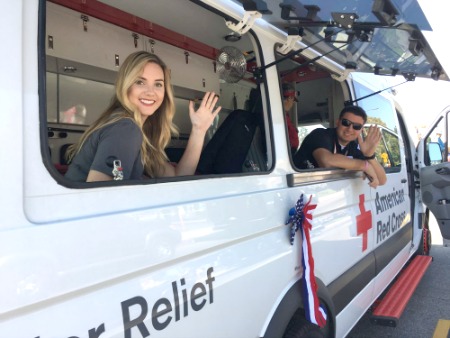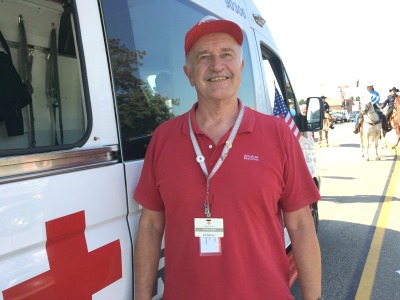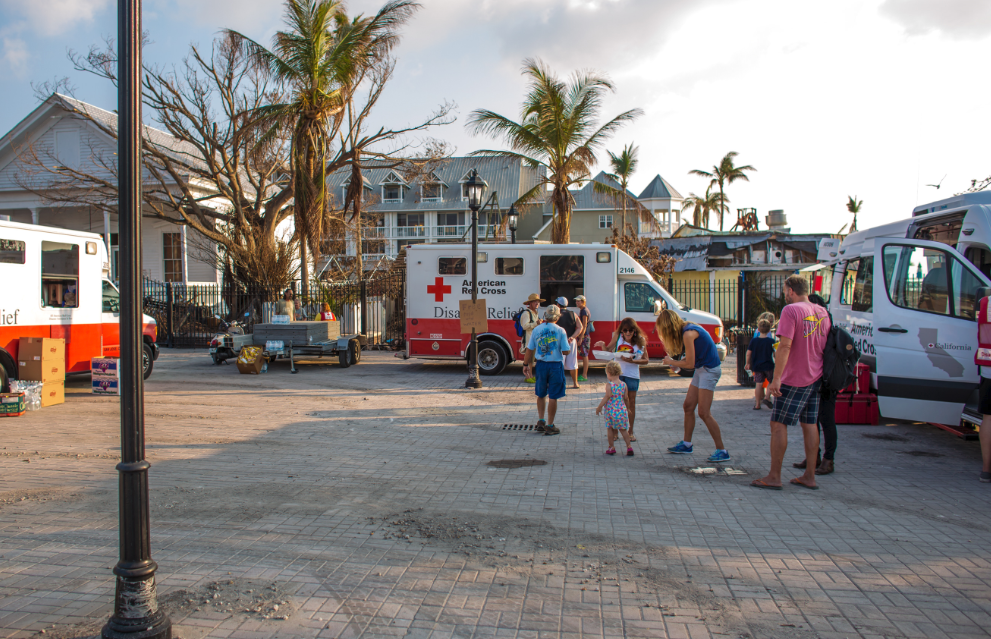By Ed Barlow, Red Cross Disaster Volunteer and ERV Driver
 (Red Cross Emergency Response Vehicles (ERVs), which are used for mobile feeding, relief supply distribution,Client Casework and other activities during national and local disasters, are also utilized at community preparedness and outreach events. Always on the move, they are a large mobile “billboard” representing the Red Cross in the communities we serve. The Los Angeles Region has 10 ERVs housed at chapter or service delivery locations across the Region, including at the West LA Regional Headquarters, the Long Beach Chapter, the Arcadia office and the Blood Center in Pomona. In addition to the eight older “box style” ERVs, the Region now has two “Next Generation” ERVs that were developed in conjunction with the Pasadena-based Art Center School of Design. ERV driver Ed Barlow had a chance to drive one of these newer vehicles in the El Monte Children’s Day Parade on Oct. 15 and here is his review.)
(Red Cross Emergency Response Vehicles (ERVs), which are used for mobile feeding, relief supply distribution,Client Casework and other activities during national and local disasters, are also utilized at community preparedness and outreach events. Always on the move, they are a large mobile “billboard” representing the Red Cross in the communities we serve. The Los Angeles Region has 10 ERVs housed at chapter or service delivery locations across the Region, including at the West LA Regional Headquarters, the Long Beach Chapter, the Arcadia office and the Blood Center in Pomona. In addition to the eight older “box style” ERVs, the Region now has two “Next Generation” ERVs that were developed in conjunction with the Pasadena-based Art Center School of Design. ERV driver Ed Barlow had a chance to drive one of these newer vehicles in the El Monte Children’s Day Parade on Oct. 15 and here is his review.)
Due to Hurricane Matthew and the massive disaster relief efforts on the East Coast, two of Los Angeles Region ERVs, based at sites in Arcadia and Pomona, were recently driven across the country to help aid the people affected by this disaster.
As a result, the Arcadia office has temporary use of one of the two new Mercedes “Sprinter” ERVs the Los Angeles Region has as part of its fleet. The “Sprinter” vehicle platform is the recent truck frame that new Red Cross ERVs are being built on, replacing the long-time Ford F-450 truck body. And I was lucky enough to get to drive it.
It provided a golden opportunity to familiarize myself with this brand new cat. Besides, keeping up with what is “state of the art” is a necessity, or we’ll all be left behind. As they said at NASA’s Jet Propulsion Lab, my former place of employment, “Progress is our most important problem!”
 Certainly some of you are miles ahead of me when it comes to having experience with these new vehicles, but since no one in the Los Angeles Region has yet to put their fingers to keyboard to discuss the differences and features of this new ERV, I decided to take a stab at it and write this blog.
Certainly some of you are miles ahead of me when it comes to having experience with these new vehicles, but since no one in the Los Angeles Region has yet to put their fingers to keyboard to discuss the differences and features of this new ERV, I decided to take a stab at it and write this blog.
There are several differences with the new ERVs. They are a bit taller, a skosh longer, and also somewhat narrower than the box version ERVs. They have back-up cameras, two easy-to-open serving windows, and two serving seats. This is great because these new ERVs can go out with four attendants— as opposed to the limit of two attendants in our previous vehicles. They still run on diesel, but use a special Diesel Exhaust Fluid to help reduce pollution. In all, the new ERVs are much easier to drive, and with a substantially roomier cab, I suspect they’ll be more comfortable on long distance deployments too.
Since the Sprinter ERV has different switches and different activation sequences, I found the online course, on Embarc, very helpful. I recommend that anyone interested in learning more about the new ERVs take this course. Along with a short walk through one of the vehicles, this course will put you more at ease with the new ERVs: the next generation of emergency response— yes, think, Star Trek!
(The Los Angeles Region is always looking for more volunteer ERV drivers. To learn more about becoming a Red Cross volunteer, please visit http://www.redcross.org/local/california/los-angeles/volunteer#step1. If you are a Red Cross volunteer and would like to become an ERV driver, you need to become an Authorized Driver with the LA Region and take some additional on-line and road training. For more information, please contact your Territory Disaster Program Manager.)
Watch this clip, of Ed Barlow’s interview with the RedCrossLA Social Media News Team: Ed Barlow Discuss the New ERV





